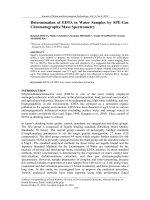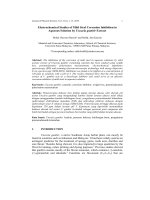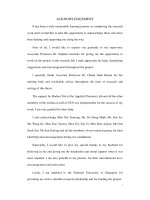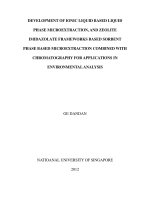Analytical capabilities of two-phase hollow-fiber liquid phase microextraction for trace multielement determination in aqueous samples by means of portable total reflection X-ray
Bạn đang xem bản rút gọn của tài liệu. Xem và tải ngay bản đầy đủ của tài liệu tại đây (799.47 KB, 11 trang )
Turk J Chem
(2016) 40: 1002 1011
ă ITAK
c TUB
Turkish Journal of Chemistry
/>
doi:10.3906/kim-1605-61
Research Article
Analytical capabilities of two-phase hollow-fiber liquid phase microextraction for
trace multielement determination in aqueous samples by means of portable total
reflection X-ray instrumentation
Eva MARGU´
I∗, Manuela HIDALGO
Department of Chemistry, University of Girona, Girona, Spain
Received: 25.05.2016
•
•
Accepted/Published Online: 31.07.2016
Final Version: 22.12.2016
Abstract: Liquid phase microextraction (LPME) procedures have been widely used in combination with atomic and
emission spectroscopic techniques for the isolation and preconcentration of trace elements. However, its application
in combination with total reflection X-ray spectrometry (TXRF) is still scarce. In this paper, we evaluate the possibilities and drawbacks of a two-phase hollow fiber LPME procedure in combination with TXRF for the simultaneous
determination of trace amounts of Cr, Ni, Cu, Zn, Pb, and Cd in aqueous samples.
After extraction of the analytes by using the optimum conditions (sample volume: 25 mL, complexing agent:
APDC, organic solvent: hexylbenzene, extraction time: 2 h, extraction speed: 660 rpm), 10 µ L of the preconcentrated
sample was deposited on a preheated quartz reflector, dried on a hot plate at 80
conditions, limits of detection lower than 3 µ g L
−1
◦
C, and analyzed by TXRF. Using such
were obtained for all metals.
In spite of LODs improvement in comparison with the direct analysis of the aqueous samples (up to a factor of
100), precision of the results was not optimal (RSD ∼ 20%). This fact may be related to the use of a low volatility solvent
as extractant phase that hampers the later TXRF analysis.
Key words: HF-LPME, TXRF, lead, cadmium, chromium, zinc, copper, nickel
1. Introduction
Multielement determination and quantification in liquid samples is a topic of great interest in many fields. Usually environmentally important elements are present in water samples at the low µ g L −1 range and the analytical techniques used for their determination include electrothermal atomic absorption spectrometry (ETAAS),
inductively coupled plasma atomic emission spectrometry (ICP-AES), and inductively coupled plasma mass
spectrometry (ICP-MS). 1−3 Although less used, total reflection X-ray spectrometry (TXRF) is also applicable
for this purpose. 4 Over the last decades, most of the published TXRF analyses were performed using largescale instruments with high-power X-ray tubes that required water-cooling systems and liquid-nitrogen cooled
detectors. 5 However, in recent years, the development and commercialization of benchtop TXRF instrumentation, offering extreme simplicity of operation in a low-cost compact design, have promoted its application in
industry as well as in research activities. 6,7 However, these systems present limited sensitivity and usually a
sample treatment procedure is needed to preconcentrate analytes and improve the detection limits. Many pre∗ Correspondence:
1002
MARGU´I and HIDALGO/Turk J Chem
concentration methods for the analysis of water samples by X-ray spectrometric techniques (including TXRF)
have been developed so far. 8,9 Taking into account the microanalytical capability of TXRF, 10 recent preconcentration strategies used in combination with TXRF have focused on the use of nanomaterials as well as liquid
phase microextraction (LPME) procedures. 11 LPME is a solvent-miniaturized sample pretreatment procedure
of the conventional liquid–liquid extraction (LLE) in which only several microliters of solvent are required to
concentrate analytes rather than hundreds of milliliters needed in traditional LLE. 12 Since its development in
the mid-to-late 1990s, LPME has been widely used to preconcentrate organic analytes 13 as well as inorganic
analytes mostly in combination with electrothermal atomic absorption spectrometry (ETAAS), flame atomic
absorption spectrometry (FAAS), or electrothermal vaporization inductively coupled plasma mass spectrometry
(ETV-ICP-MS). 14,15 Different LPME modes have been developed including hollow fiber LPME (HF-LPME),
dispersive liquid–liquid microextraction (DLLME), and single drop LPME (SD-LPME). Some recently published papers have shown the possibilities of DLLME as a preconcentration strategy to be used in combination
with TXRF for the determination of trace levels of Cd as well as Sb species in waters. 16,17 However, there is
an absolute lack of information about the possibilities of HF-LPME in combination with TXRF for multielement analysis of aqueous samples. Therefore, the aim of this contribution was to develop a method based on
HF-LPME for the simultaneous determination of Cr, Ni, Cu, Zn, Pb, and Cd in aqueous samples by TXRF
and to explore the analytical capabilities for such purpose. For that, in the first stage, parameters affecting
both the extraction procedure and TXRF analysis were carefully evaluated to ensure the best sensitivity for
multielement determination. Then analytical figures of merit including limits of detection, linearity, accuracy,
and precision were evaluated.
2. Results and discussion
2.1. Selection of experimental conditions for multielement extraction by HF-LPME
According to the literature, 15 in HF-LPME systems, the extractant phase should have low solubility in water
to avoid its dissolution and low volatility to reduce evaporation of the solvent during extraction. Moreover,
the extractant should have an adequate polarity so that it can be immobilized within the pores of the hollow
fiber, avoiding solvent leakage. In the present contribution, the suitability of several organic solvents including
undecane, dihexyl ether, decalin, hexylbenzene, and toluene was tested for such purpose. In a previous work,
we demonstrated the usefulness of carbon tetrachloride as extractant solvent in a DLLME-TXRF system. 16
Therefore, in spite of the higher volatility of this solvent compared to the aforementioned ones, we evaluated
also the possibilities of using this solvent in the HF-LPME configuration. It is well known that hydrophobic
analytes are easily extracted into organic solvents from aqueous solutions. Therefore, for proper extraction of
metals present in an aqueous solution, an adequate complexing agent should be added to the sample to form
metal chelates with low solubility in water. For that, APDC and 8-hydroxyquinoline were tested taking into
account their widespread use as complexing agents in metal preconcentration procedures. 18,19
Preliminary extraction tests were carried out with 25 mL of an aqueous solution containing Cr, Ni, Cu,
Zn, Cd, and Pb at the level of 50 µ g L −1 . First, an adequate amount of APDC and 8-hydroxyquinoline was
added to the aqueous sample to obtain a final concentration of 0.25% (w/v) and then the pH was adjusted to 7
and 8, respectively, taking into consideration previous reported studies dealing with the use of such complexing
agents. 18,19 In both cases, 100 µ L of all the organic solvents mentioned above were tested as extraction phase
placed inside the HF. The impregnated HF was then immersed into the aqueous solution and the extraction
was carried out for 2 h under magnetic agitation.
1003
MARGU´I and HIDALGO/Turk J Chem
For both systems (APDC/8-hydroxyquinoline), toluene and carbontetrachloride were not recovered from
the HF after the preconcentration procedure. For that, these solvents were discarded to be used in the HFLPME configuration. In the case of 8-hydroxyquinoline, only a significant Cu signal was obtained when using
dihexyl ether as organic phase. In contrast, when using APDC as complexing agent, interesting results were
obtained for most of the studied elements using decalin or hexylbenzene as extractant phases (see Figure 1).
Since the aim of this manuscript was the development of a multielement method of preconcentration, APDC was
finally selected as complexing agent and decalin and hexylbenzene as extractant phases for further experiments.
Figure 1. Effect of organic solvent used for multielement extraction when using HF-LPME (configuration 2: 50 µ g
L −1 metals, 25 mL aqueous sample, APDC 0.25% (w/v), pH 6–7, extraction time: 2 h, 50 µ L organic solvent inside the
hollow fiber).
In addition to the extractant and the complexing agent, other parameters affecting metal extraction
(extraction time, sample pH, sample volume, and extraction speed) were evaluated to obtain high analyte
preconcentration rates. One variable at a time optimization was used to obtain the best favorable conditions for
the HF-LPME procedure. All the experiments were carried out using an aqueous standard containing Cr, Ni,
Cu, Zn, Cd, and Pb at the level of 50 µ g L −1 and an APDC concentration of 0.25%. HF dimensions were 4.5
cm length (4.0 effective length) with an internal diameter of 600 µ m. The use of a thinner HF was discarded
due to the insufficient organic solvent volume recovered after the preconcentration procedure to carry out later
TXRF analyses.
Extraction time is a significant parameter in HF-LPME systems and it was firstly evaluated. In Figure
2A, as an example, the analytical TXRF signal for Zn is shown at different extraction times (from 30 to 600 min)
using hexylbenzene and decalin as extractant phases. As shown, for both solvents, metal extraction is increasing
up to 600 min. However, as a compromise between the extraction rate and the extraction time, 120 min was
used to perform the subsequent experiments. Moreover, from Figure 2A, it can be deduced that analytical
TXRF signals obtained when using decalin as extractant phase were lower than when using hexylbenzene.
Similar trends were found for other studied elements (for additional information see Supporting information).
Therefore, hexylbenzene was selected as organic phase to recover metals inside the HF.
The effect of pH on the formation and extraction of the ADPC-metal complexes was also studied and
it was found that the metal signals were higher and relatively constant in the pH range of 6–8. Taking into
account that the pH of natural waters is usually within the range of 6–7, the pH adjustment of the sample was
not necessary.
Another parameter that can affect the sensitivity of the preconcentration procedure is the volume of
the aqueous sample. To evaluate this effect, we compared TXRF spectra obtained for the analysis of a
preconcentrated sample using aliquots of 25 mL or 500 mL of the initial aqueous sample. The results obtained
1004
MARGU´I and HIDALGO/Turk J Chem
are displayed in Figure 2B. As shown, the improvement in the analytical signal was almost negligible increasing
the volume 20 times. This fact can be explained considering a worst contact between the fiber and the solution
when using higher sample volumes that lead to a limited extraction of the metals inside the HF. Therefore, a
volume of 25 mL was set since, within the two volumes studied, it entails less consumption of reagents.
Figure 2. Effect of: (A) extraction time (50 µ g L −1 metals, 25 mL aqueous sample, APDC 0.25% (w/v), pH 6–7), (B)
aqueous sample volume (50 µ g L −1 metals, 50 µ L hexylbenzene, APDC 0.25% (w/v), pH 6–7, extraction time: 2 h),
(C) extraction speed (50 µ g L −1 metals, 50 µ L hexylbenzene, APDC 0.25% (w/v), pH 6–7, extraction time: 2 h) on
element determination using the HF-LPME-TXRF system.
To speed up the extraction process when using HF-LPME procedures, usually the sample is stirred.
Stirring rate is therefore another significant parameter to be tested. Increasing stirring speeds (within the range
110–770 rpm) were used for the extraction (2 h) of standard solutions containing 50 µ g L −1 of the target
metals. The obtained results in terms of TXRF signal are displayed in Figure 2C. In general, an increase in
the analytical signal was obtained when using stirring speeds up to 660 rpm. Using higher speeds (770 rpm) a
strong wave was originated at the top-center of the solution that hampers the extraction process and, as shown
in Figure 2C, the analytical signal decreased. Based on the obtained results, a stirring rate of 660 rpm was
selected.
2.2. Selection of operating conditions for TXRF measurements
As stated in the introduction section, in order to work under conditions of total reflection, samples must be
presented as thin layers ( <100 µ m) on a reflective carrier. Moreover, the diameter of the sample spot on the
sample carrier has to be within the beam size to ensure the entire exposition of the drop to the X-ray beam. For
aqueous samples this is accomplished by depositing 5–50 µ L of the sample on the carrier and drying the drop
1005
MARGU´I and HIDALGO/Turk J Chem
under heating. 20 However, when analyzing organic solvents, a careful evaluation of the sample volume as well
as of the drying mode should be carried out in order to ensure proper preparation for the later TXRF analysis.
For that reason, a first test was performed in order to study the effect of the sample deposition volume
(sample preconcentrated in hexylbenzene) on the obtained TXRF results. The use of volumes higher than 10
µ L was discarded because of the long time required to dry the organic drop. The data obtained are presented in
Figure 3. As seen, a significant increase in the elements’ TXRF response was found when using a total volume
of 10 µ L but using two consecutive depositions of 5 µL in the same location with time allowed for droplet
drying between depositions. Based on the obtained results, this sample deposition approach was used in further
experiments.
Figure 3. Effect of preconcentrated sample deposition volume on the quartz reflector for TXRF analysis (analytical
conditions: [Metals] = 50 µ g L −1 , 25 mL aqueous phase, extraction time: 2 h, stirring rate: 660 rpm).
Another set of tests was conducted to select the best way to dry the drop as a centered film on the
reflector: (i) drying at room temperature (under a laminar flow hood), (ii) drying under an IR-lamp, (iii)
drying on a hot plate (T = 80 ◦ C). It was found that the only way to avoid the unwanted movement of the
organic drop to the reflector’s edges during the drying step and thus obtaining a centered thin film on the
reflector surface was the deposition of the drop on a preheated reflector and using an additional heating step
on a hot plate set at 80 ◦ C.
Regarding the instrumental conditions, the rate of kV/mA (50/1) of the X-ray tube was selected to work
under conditions of maximum efficiency of excitation (max. power of the X-ray tube 60 W). Measurement time
was set at 1000 s as a trade-off between an acceptable instrumental sensitivity, repeatability of measurements,
and total analysis time.
2.3. Analytical figures of merit and analytical possibilities of HF-LPME-TXRF system
Limits of detection for the HF-LPME-TXRF system were theoretically estimated from the element peak
intensities and background values obtained in the TXRF analysis of a preconcentrated aqueous standard
containing 50 µ g L −1 of each element, according to the following equation:
LOD =
3Ci
√
Nbkg
Ni
where C i is the concentration of a given analyte, N bkg is the background area, and N i is the net area of the
analyte.
Obtained values are shown in Table 1. For comparison purposes, limits of detection calculated for the
direct analysis (without preconcentration) of an aqueous standard containing 500 µ g L −1 of each element are
1006
MARGU´I and HIDALGO/Turk J Chem
also displayed. As can be seen, limits of detection when using the HF-LPME procedure as preconcentration step
are, for all the studied elements, at the low µg L −1 level. These values are significantly improved in comparison
to the direct TXRF analysis. This fact is particularly interesting when using portable TXRF systems that offer
extreme simplicity of operation in a low-cost compact design (no cooling media or gas consumption are required
for operation) but they also present limited sensitivity compared with high-scale instrumentation. Although
the LODs achieved are rather higher than those associated with other popular spectrometric techniques such
as ETAAS 21 and ICP-MS (after electrothermal vaporization) 22 in combination with HF-LPME, they are low
enough for most environmental studies.
Table 1. Analytical figures of merit for the HF-LPME-TXRF system. Concentrations are expressed in µ g L −1 .
Element
LODa
Cr
Ni
Cu
Zn
Pb
Cd
1.8 (180)
2.8 (100)
2.3 (105)
1.0 (102)
0.5 (22)
3 (34)
Linearity
Range Slope
5–50
3.257
5–70
4.858
5–40
3.488
5–50
13.853
10–70 10.726
5–50
1.695
2
R
0.996
0.991
0.990
0.993
0.999
0.991
RSD (%, n = 4)b
Without IS With IS (Mo)
26
4
40
17
6
20
14
70
24
15
16
4
LOD: limit of detection, IS: internal standard correction.
a
in parentheses are reported the detection limits without preconcentration (direct analysis of an aqueous sample).
b
RSD was calculated from four-replicate analysis of an aqueous standard containing 30 µ g L −1 of each metal.
The linearity of the proposed analytical methodology was examined for the concentration of analytes
in the range of 5–100 µ g L −1 . The obtained results showed that the linear concentration range is highly
dependent on the element (see Table 1 for details). However, for all the studied elements, the linear range is up
to 50–70 µ g L −1 concentration level. This is in agreement with other published scientific papers dealing with
the use of HF-LPME as preconcentration procedure. 23,24 As is widely known, the slope of the calibration curve
is related to method sensitivity. Taking into account the slope values displayed in Table 1, it is apparent that
the sensitivity for the proposed HF-LPME-TXRF method is higher for Pb and Zn and lower for Cd.
The global precision of the developed analytical procedure was evaluated in terms of relative standard
deviation (RSD) of four-replicate analysis of solutions containing 30 µ g L −1 of the target metals. As shown in
Table 1, RSD values obtained (RSD ∼ 6%–40%) were in most cases higher than those in other published studies
dealing with the use of HF-LPME in combination with electrothermal vaporization ICPMS (RSD ∼ 6%–13%). 25
This may be related to the uncertainty associated with the deposition and drying of few microliters of an organic
solvent (preconcentrated sample) on the reflective carrier to perform TXRF analysis. When analyzing organic
solvents, due to their higher boiling points, the deposition of a proper sample volume on the reflector as well
as the drying mode is critical. In order to minimize the uncertainty associated with sample deposition on
the global precision, the use of an internal standard was tested. For that, an adequate volume of a Mo stock
solution of 1000 mg kg −1 in oil matrix was diluted with hexylbenzene up to 10 mg kg −1 . Then the resulting
solution was used as organic phase for the preconcentration of 25 mL of an aqueous standard containing 30 µ g
L −1 of the target metals. However, it was found that part of the Mo initially located inside the HF moved to
the aqueous phase during the extraction procedure and therefore this approach was discarded as a strategy to
correct sample deposition uncertainties. Taking into account these results, it was considered appropriate to add
1007
MARGU´I and HIDALGO/Turk J Chem
the internal standard to the organic phase after performing the preconcentration procedure. In this case, 30 µ L
of a preconcentrated aqueous standard containing 30 µ g L −1 of the target metals was carefully mixed with 10
µ L of a Mo standard solution of 10 mg kg −1 . This procedure was repeated four times and RSD values from
the obtained results were calculated and are displayed in the last column of Table 1. As can be seen, there is
not a clear improvement tendency for all the metals using internal standard correction. Moreover, using such
an approach the sample is diluted by a factor of 1/4 , which is critical for trace analysis. For these reasons,
internal standard correction was discarded.
Finally, in order to check the analytical possibilities of the developed HF-LPME-TXRF method for the
analysis of water samples, the system was applied to the analysis of a spiked river water at the level of 30
µ g L −1 of the target metals (ICP-MS analysis of the raw river water showed that all the studied metals were
present at concentrations less than 1 µ g L −1 ). In Figure 4 the TXRF spectrum for the aforementioned spiked
river water sample is displayed. As shown, in addition to the peaks of the studied metals (Cr, Ni, Cu, Zn, Pb,
and Cd) detectable peaks of Si (from the reflector), S (from the APDC), Ar (from the air), and Fe are also
present. Calculated recoveries were 105% for Cr, 97% for Ni, 81% for Cu, 115% for Zn, 115% for Cd, and 112%
for Pb.
Pulses
Pulses
80
30
60
Cu-Kα
20
Ni-K α
Zn-KαPb-Lα
Pb-Lβ
Cr-K α
10
Cd-K α
Si
40
0
20
Zn
S
Ar
Cr
5
10
15
- keV -
20
25
Pb
Ni
Fe Cu
Cd
0
0
10
20
30
40
Energy (kev)
Figure 4. TXRF spectrum for a spiked aqueous sample with 30 µ g L −1 of Cr, Ni, Cu, Zn, Pb, and Cd (analytical
conditions: 25 mL aqueous sample, 0.25% APDC, pH 6–7, 50 µ L hexylbenzene, 2 h extraction time, 660 rpm agitation
speed, 5 + 5 µ L deposition volume, drying at 80
◦
C on a hot plate, 1000 s measurement time).
3. Experimental
3.1. Reagents and solutions
Stock solutions of 1000 ± 0.5 µ g mL −1 (Spectroscan, TECKNOLAB A/S, Norway) of appropriate elements
were used to prepare standard solutions and spiked samples. High purity water used for dilution of stock
solutions and samples was obtained from a Milli-Q purifier system operated at 18 M Ω (Millipore Corp., Bedford,
MA, USA). The solution of 10 mg/kg of Mo used for internal standardization was obtained by appropriate
1008
MARGU´I and HIDALGO/Turk J Chem
dilution of Mo stock solution of 1000 µ g/g in an oil matrix (High-Purity standards, USA). This metallorganic
standard shows high solubility and could be easily employed as an internal standard in organic matrices.
All organic solvents used through the work (hexylbenzene, undecane, carbon tetrachloride, dihexyl
ether, decalin, and toluene) were of analytical grade quality (Sigma-Aldrich, Spain). The complexing agents,
ammonium pyrrolidine dithiocarbamate-APDC (>99%) and 8-hydroxyquinoline, were also purchased from
Sigma-Aldrich (Spain). The pH values were adjusted by addition of ammonia and nitric acid solutions (Merck,
Spain). The hollow fiber polypropylene membrane (600 µ m i.d., 200- µ m wall thickness, 0.2- µ m pore size) was
obtained from AKZO Nobel (Germany).
3.2. Hollow fiber liquid phase microextraction procedure and TXRF analysis
In the present contribution a two-phase HF-LPME procedure in combination with TXRF was tested for the
simultaneous determination of Cr, Ni, Cu, Zn, Cd, and Pb in aqueous solutions. Extraction parameters
(HF-LMPE) and operating conditions (TXRF) were carefully evaluated in order to ensure best results for
multielement analysis. In Figure 5 a schematic overview of the proposed method is displayed. In brief, first the
polypropylene hollow fiber (HF) was cut into 4.5-cm length segments. A plastic pipette tip was connected to
one of the ends of the fiber and the other end was thermally sealed. The fiber was immersed into the organic
solvent for about 30 s to impregnate the pores of the hollow fiber with the organic solvent. Then a 100-µ L
microsyringe with a needle of 0.5 mm outer diameter was used to introduce the organic solvent into the lumen
of the hollow fiber for extraction. Care was taken to avoid any air bubbles. By this preparation, the effective
fiber length was 4.0 cm with an organic phase volume of ∼ 90 µ L. The impregnated HF was then immersed into
25 mL of the aqueous sample solution containing 0.25% (w/v) of APDC and adjusted to pH 6–7 (by addition
of ammonia or nitric acid solutions). The extraction was carried out for 2 h under a magnetic agitation speed
of 660 rpm, and then the acceptor solution (containing the analytes) was collected by using a microsyringe.
For TXRF analysis, a preconcentrated sample aliquot of 5 µ L was transferred onto a preheated quartz sample
carrier and dried on a hot plate (T ∼80 ◦ C). This procedure was performed twice (5 + 5 µ L) before TXRF
analysis.
Figure 5. Schematic setup for the HF-LPME-TXRF system for multielement determination of Cd, Cr, Zn, Cu, Pb,
and Ni in aqueous samples.
1009
MARGU´I and HIDALGO/Turk J Chem
3.3. Instrumental and operating conditions
TXRF analysis of the preconcentrated samples was performed with the benchtop spectrometer S2 PICOFOX
(Bruker AXS Microanalysis GmbH, Berlin, Germany). The spectrometer specifications and operating conditions
used are summarized in Table 2. This instrument is equipped with a W X-ray tube that allows TXRF analysis
using K-lines of high atomic number elements such as Cd. An additional advantage of this spectrometer
compared to other existing systems is that it uses an air-cooled low-power X-ray tube and a Peltier cooled
silicon drift detector and thus no cooling media and gas consumption are required.
Table 2. Instrumental parameters and measurement conditions.
S2 PICOFOX TXRF benchtop spectrometer (Bruker AXS, Germany)
X-ray tube
W
Rating
50 kV, 1 mA (maximum power 50 W)
Optics
Multilayer Ni/C, 35.0 keV, 80% reflectivity
Detector
Si drift detector, 10 mm2 , <160 eV resolution Mn-Kα
Working environment Air
Sample station
Cassette changer for 25 samples
Size, weight
600 × 300 × 450 mm, 37 kg
Measurement time
1000 s
Analytical lines
Cr-Kα (5.415 keV)
Ni-Kα (7.480 keV)
Cu-Kα (8.046 keV)
Zn-Kα (8.637 keV)
Pb-Lα (10.551 keV)
Cd-Kα (23.173 keV)
4. Conclusions
In this contribution we tested the possibilities and drawbacks of two-phase HF-LPME as a relatively simple
and inexpensive preconcentration procedure to improve the elemental sensitivity of low-power TXRF systems
for aqueous sample analysis. The results showed that using such an analytical approach limits of detection can
be improved by a factor of 100 (depending on the analyte) in comparison with direct analysis of the aqueous
samples. Another interesting advantage of HF-LPME-TXRF configuration is the possibility of simultaneous
determination of several elements (Cr, Ni, Cu, Zn, Cd, and Pb). Most of the published contributions dealing
with the use of LPME procedures are focused on the determination of a single or a limited number of elements.
However, despite the advantages in terms of sensitivity improvement of two-phase HP-LPME procedures,
the use of a low volatility solvent as extractant phase hampers the attainment of precise results (RSD ∼20%)
and hinders the application of this analytical approach for multielemental analysis of water samples by TXRF.
To tackle this issue, further experiments will be focused on the possibilities of three-phase HP-LPME systems in
combination with TXRF. In such extraction mode, analytes are extracted from an aqueous sample through the
organic solvent (immobilized into the pores of the hollow fiber) into an aqueous acceptor solution. Therefore,
this mode seems more compatible with the later TXRF analysis.
Acknowledgments
This work was supported by the Spanish National Research Program (Project ref. CGL2013-48802-C3-2-R).
The authors want to acknowledge Anna Also for her help during the laboratory work.
1010
MARGU´I and HIDALGO/Turk J Chem
References
1. Lima, A. M. S.; Ara´
ujo, D. G. G. R.; Ferreira, S. L. C. Microchem. J. 2016, 126, 368-372.
2. Butler, O. T.; Cairns, W. R. L.; Cook, J. M.; Davidson, C. M. J. Anal. At. Spectrom. 2016, 31, 35-89.
3. Dehouck, P.; Cordeiro, F.; Snell, J.; De La Calle, B. Anal. Bional. Chem. 2016, 408, 3223-3232.
4. Borgese, L.; Bilo, F.; Tsuji, K.; Fern´
andez-Ruiz, R.; Margui, E.; Streli, C.; Pepponi, G.; Stosnach, H.; Yamada,
T.; Vandenabeele, P.; et al. Spectrochim. Acta Part B 2014, 101, 6-14.
5. Carvalho, M. L.; Barreiros, M. A.; Costa, M. M.; Ramos, M. T.; Marques, M. I. X-Ray Spectrom. 1996, 25, 29-32.
6. Stosnach, H. Spectrochim. Acta Part B 2010, 65, 859-863.
7. Dalipi, R.; Margui, E.; Borgese, L.; Bilo, F.; Depero, L. E. Spectrochim. Acta Part B 2016, 120, 37-43.
8. Van Grieken, R. Anal. Chim. Acta 1982, 143, 3-34.
9. Margui, E.; Van Grieken, R.; Font`
as, C.; Hidalgo, M.; Queralt, I. Appl. Spectrosc. Rev. 2010, 45, 179-205.
10. Klockenkă
amper, R. Total Reflection X-ray Fluorescence Analysis; Wiley Interscience: New York, NY, USA, 1997.
11. Margui, E.; Zawisza, B.; Sitko, R. Trends Anal. Chem. 2014, 53, 73-83.
12. Sarafraz-Yazdi. A.; Amiri, A. Trends Anal. Chem. 2010, 29, 1-14.
13. Pena-Pereira, F.; Lavilla, I.; Bendicho, C. Trends Anal. Chem. 2010, 29, 617-628.
14. Dadfarnia, S.; Shabani, A. M. H. Anal. Chim. Acta 2010, 658, 107-119.
15. Pena-Pereira, F.; Lavilla, I.; Bendicho, C. Spectrochim. Acta Part B 2009, 64, 1-15.
16. Margui, E.; Queralt, I.; Hidalgo, M. J. Anal. At. Spectrom. 2013, 28, 266-273.
17. Margui, E.; Sagu´e, M.; Queralt, I.; Hidalgo, M. Anal. Chim. Acta 2013, 786, 8-15.
18. Feist, B.; Mikula, B. Food. Chem. 2014, 147, 225-229.
19. Kocot, K.; Zawisza, B.; Margui, E.; Queralt, I.; Hidalgo, M.; Sitko, R. J. Anal. At. Spectrom. 2013, 28, 736-742.
20. Margui, E.; Tapias, J. C.; Casas, A.; Hidalgo, M.; Queralt, I. Chemosphere 2010, 80, 263-270.
21. Peng, J. F.; Liu, R.; Liu, J. F.; He, B.; Hu, X. L.; Jiang, G. B. Spectrochim. Acta Part B 2007, 62, 499-503.
22. Xia, L.; Wu, Y.; Hu. B. J. Mass Spectrom. 2007, 42, 803-810.
23. Jiang, H.; Hu, B.; Chen, B.; Xia, L. Anal. Chim. Acta 2009, 634, 15-21.
24. Xia, L.; Hu, B.; Jiang, Z.; Wu, Y.; Chen, R.; Li, L. J. Anal. At. Spectrom. 2006, 21, 362-365.
25. Guo, X.; He, M.; Chen, B.; Hu, B. Talanta 2012, 101, 516-523.
1011
Supporting Information
Effect of extraction time on element determination using the HF-LPME+TXRF system
(Analytical conditions: 50 µg L-1 metals, 25 mL aqueous sample, APDC 0.25 % (w/v),
pH = 6-7).
1









